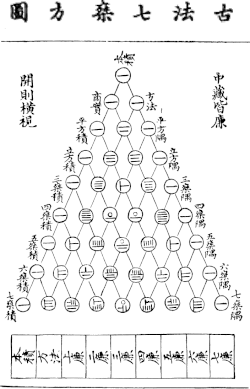Yang Hui



Yang Hui(simplified Chinese:Dương huy;traditional Chinese:Dương huy;pinyin:Yáng Huī,ca. 1238–1298),courtesy nameQianguang(Khiêm quang), was a Chinese mathematician and writer during theSong dynasty.Originally, from Qiantang (modernHangzhou,Zhe gian g), Yang worked onmagic squares,magic circlesand thebinomial theorem,and is best known for his contribution of presentingYang Hui's Triangle.This triangle was the same asPascal's Triangle,discovered by Yang's predecessorJia Xian.Yang was also a contemporary to the other famous mathematicianQin Jiushao.
Written work
[edit]The earliest extant Chinese illustration of 'Pascal's triangle' is from Yang's bookXiangjie Jiuzhang Suanfa(Tường giải chín chương thuật toán)[1]of 1261 AD, in which Yang acknowledged that his method of finding square roots and cubic roots using "Yang Hui's Triangle" was invented by mathematicianJia Xian[2]who expounded it around 1100 AD, about 500 years before Pascal. In his book (now lost) known asRújī Shìsuǒ(Như tích thích khóa) orPiling-up Powers and Unlocking Coefficients,which is known through his contemporary mathematicianLiu Ruxie(Lưu nhữ hài).[3]Jia described the method used as 'li cheng shi suo' (the tabulation system for unlocking binomial coefficients).[3]It appeared again in a publication ofZhu Shijie's bookJade Mirror of the Four Unknowns(Bốn nguyên ngọc giám) of 1303 AD.[4]
Around 1275 AD, Yang finally had two published mathematical books, which were known as theXugu Zhaiqi Suanfa(Tục cổ trích kỳ thuật toán) and theSuanfa Tongbian Benmo(Thuật toán thông biến đầu đuôi,summarily called Yang Hui suanfaDương huy thuật toán).[5]In the former book, Yang wrote of arrangement of natural numbers around concentric and non concentric circles, known asmagic circlesand vertical-horizontaldiagramsof complexcombinatorialarrangements known asmagic squares,providing rules for their construction.[6]In his writing, he harshly criticized the earlier works ofLi ChunfengandLiu Yi(Lưu ích), the latter of whom were both content with using methods without working out their theoretical origins or principle.[5]Displaying a somewhat modern attitude and approach tomathematics,Yang once said:
- The men of old changed the name of their methods from problem to problem, so that as no specific explanation was given, there is no way of telling their theoretical origin or basis.[5]
In his written work, Yang provided theoretical proof for the proposition that the complements of theparallelogramswhich are about the diameter of any given parallelogram are equal to one another.[5]This was the same idea expressed in the Greek mathematicianEuclid's (fl. 300 BC) forty-third proposition of his first book, only Yang used the case of a rectangle andgnomon.[5]There were also a number of other geometrical problems and theoretical mathematical propositions posed by Yang that were strikingly similar to the Euclidean system.[7]However, the first books of Euclid to be translated into Chinese was by the cooperative effort of the Italian JesuitMatteo Ricciand theMingofficialXu Guangqiin the early 17th century.[8]
Yang's writing represents the first in whichquadratic equationswith negative coefficients of 'x' appear, although he attributes this to the earlier Liu Yi.[9]Yang was also well known for his ability to manipulate decimal fractions. When he wished to multiply the figures in a rectangular field with a breadth of 24 paces 34⁄10ft. and length of 36 paces 28⁄10,Yang expressed them in decimal parts of the pace, as 24.68 X 36.56 = 902.3008.[10]
The Yang-Hui Award
[edit]The Yang-Hui Award is presented to mathematicians or scientists who have gained international recognition for their exceptional contributions throughout their careers.[11]It was awarded to Salvatore Capozziello for his work withNoether symmetries;Mahouton Norbert Hounkonnoufor his work in deformed quantum algebras; and to Delfim F. M. Torres for his mathematical modelling ofCOVID-19in 2023 at the International Conference on Mathematical Analysis, Applications and Computational Simulation (ICMAACS 2023), Shanghai, China, November 22-26, 2023.[12][13]
See also
[edit]Notes
[edit]- ^Fragments of this book was retained in the Yongle Encyclopedia vol 16344, in British Museum Library
- ^Needham, Volume 3, 134-137.
- ^abNeedham, Volume 3, 137.
- ^Needham, Volume 3, 134-135.
- ^abcdeNeedham, Volume 3, 104.
- ^Needham, Volume 3, 59-60.
- ^Needham, Volume 3, 105.
- ^Needham, Volume 3, 106.
- ^Needham, Volume 3, 46.
- ^Needham, Volume 3, 45.
- ^"International Conference on Mathematical Analysis, Applications and Computational Simulation - Awards".ICMAACS.
- ^"International Conference on Mathematical Analysis, Applications and Computational Simulation - Awardees".ICMAACS.2023-10-13.
- ^Gayet, Donald Kévin (2023-10-15)."Mathématique: le Béninois Norbert Hounkonnou distingué en Chine par le prix Yang-Hui"[Mathematics: Beninese Norbert Hounkonnou, distinguished in China by the Yang-Hui Prize].Banouto(in French).Retrieved2024-08-20.
References
[edit]- Needham, Joseph (1986).Science and Civilization in China: Volume 3, Mathematics and the Sciences of the Heavens and the Earth.Taipei: Caves Books, Ltd.
- Li, Jimin,"Yang Hui".Encyclopedia of China(Mathematics Edition), 1st ed.
